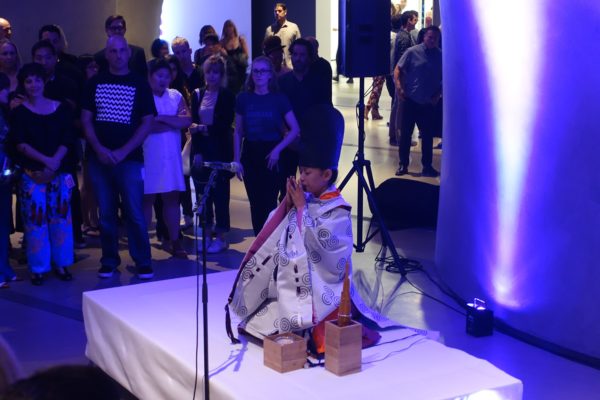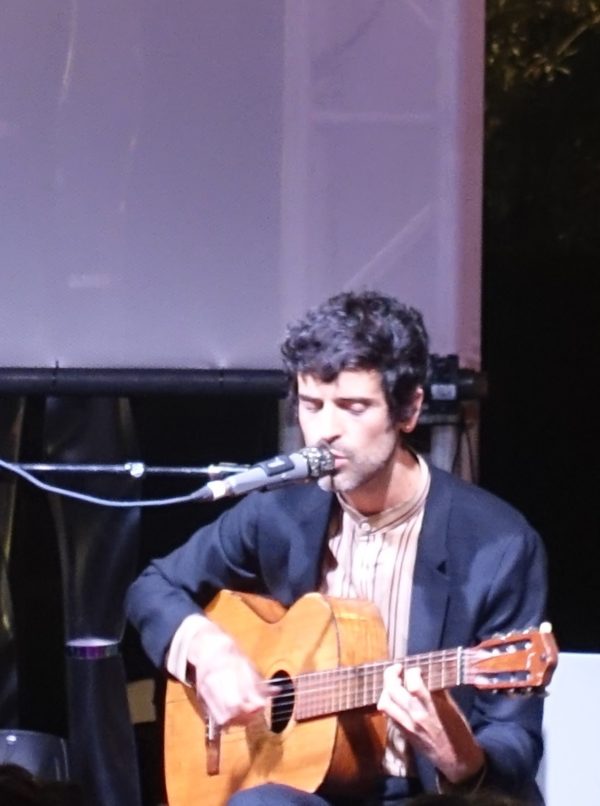Have you ever been at a party, laughing convulsively while draining your second glass of prosecco, and then suddenly, with a cold, horrified shiver, thought—wait, oh no, someday I’m going to be dead? That’s what the work of Takashi Murakami is like. Murakami, the Japanese deployer of high/low anime-rich iconography, grew famous in the 1990s for his “superflat” installations and paintings. From the start, aficionados flocked to the happy distractions Murakami’s cartoon colors, cute little figurines, and celebrations of Japan’s baby gamer otaku culture. Yet even in the artist’s early 1999 work DOB in the Strange Forest (Blue DOB), he positioned a cheerful blue bunny person in a grove of luminous mushrooms that turned out to be signifiers of the A-bomb.

In the Land of the dead mural
Last Saturday, the Broad’s second annual Summer Happening, appropriately titled Strange Forest, studied Murakami’s frantic melancholy with an all-music, heavily J-Pop lineup that brought kaleidoscopes of neon and aerobic punk to downtown. The bash began with DJ Bae Bro, who enticed spectators away from the bar’s allurements with pianissimo jazz riffs morphing into R2D2 whines combined with contagious heavy beats. At this point, all was well: You couldn’t detect even a whiff of doom as spectators enjoyed the music while sitting down on the plaza’s grass and eating snacks.

Ibid
The crowd got to its feet, though, when the wicked witches of Afrirampo showed up: Oni and Pika, with their ponytails, polka-dotted faces, and cerulean bra tops, began rampaging the campus, mournfully yelling out You are a beautiful woman and I want to be a beautiful woman and You are a strong man. From having studied the group on Youtube, we here at Artillery knew that Afrirampo was initiating a poignant call-and-response mating ritual with the audience. Apparently nobody else had done their research, though. We thus found ourselves the sole person yelling back I want to be a beautiful woman while receiving about 200 side-eyes, which gave us the exciting sensation described at the beginning of this essay. Then Afrirampo leapt onstage and thrashed awesomely on their drums and guitar and screamed out pop pop pop pop pop pop pop.

Ibid
We thereafter fled to the lobby, where the musician and dancer Tokiko Ihara sat on a small stage, dressed in a tall blue crown made of felt and a beautiful white robe painted with gold trefoils. She brought a Ho-Sho flute to her lips, composed of 17 bamboo pipes, and which first emitted a high pitched screech before melding into a gorgeous organ-like harmony The deep resonance of this music settled its vibrations into the body, and this quality, combined with Ihara’s focused presence, gave the observer the sensation of participating in a thoughtful ritual that deserved audience silence and deep attention. Such is not the environment of the Broad’s plaza, however. The clash of this numinous performance with the fretful, scattered, chattering energy of patrons evoked a feeling of loneliness and fatal misunderstanding that is of a piece with Murakami’s meanings.

Dustin Wong and Takako Minekawa
Oorutaichi, singing incomprehensibly in the Oculus Hall, added to this theme of exquisite agony. The Kyoto resident dispenses with audience accessibility by writing songs in an invented language. He danced groovily in front of his computer while wearing a black button-down that somehow had what looked like two polo shirts stuffed into the sleeves. Closing his eyes, he sang plangent odes that sounded like sonnets about being chronically unrequited. The performance recalled the art of teenage geniuses who talk to themselves in their bedrooms and don’t get a lot of sunlight.

Devendra Banhart
But now it was time to race back to the plaza to see superstar Devendra Banhart, whom we guess everybody loves and is a heartthrob. Women began literally screaming and couples started making out as Banhart sat down in a chair and played his guitar, welcoming his audience in both Spanish and English. This was all good, except that we didn’t quite understand the Murakami connection but for the fact that Banhart’s newest album, Ape in Pink Marble, “embraces” Japanese culture—that is, that Banhart and his bandmates recorded tracks in Los Angeles while imagining that they were actually in a Tokyo fleabag hotel. As we ducked beneath the flailing arms of shrieking fangirls, we thought that this curious appropriations strategy recalled the strange adventures of the 20th-century poet Ezra Pound, who translated Chinese poetry without knowing any Chinese at all, though fantasizing that he did. Pound was arrested for treason right after World War II and spent 12 years getting treated for a nuclear case of Narcissistic Personality Disorder in a Washington, D.C. sanitarium. This association lent Banhart’s performance a gloomy Murakami undercurrent, though perhaps not one that was intended.

Tokiko Ihara
Our confusion over what constitutes crazy cultural theft vs. artistic freedom so mesmerized us that we missed the amazing nowave drummer Ikue Mori. But thank God for the Tokyo-based Dustin Wong and Takako Minekawa, who offered a complement to Murakami’s candy-bright In the Land of the Dead, Stepping on the Tail of the Rainbow (2014), which hangs in Gallery 303 as a memorial for the Tōhoku and Fukushima victims. Wong and Minekawa conjure danceable symphonies like She He See Feel on guitar, synthesizer and computers. Their wiggly rhythms and light vocals gave the sensation of feeling really happy while riding a bike in the suburbs, but then all of a sudden, they scarified their cartwheel ebullience with dark chorals that hinted at life’s brevity and love’s illusion.

Miho Hatori
The night closed down on an upnote with NYC’s Miho Hatori, who has made a career out of what she calls the “New Optimism.” Apparently she’s not being ironic, as she danced with cool joie de vivre and sang in synthesizer-blurred vocals back at the Oculus. Hatori says things like “music is my sunlight” and filled her audience with folks who wore miner’s headlamps that cast wacky golden shapes on the walls as she performed flanked by two hard-rocking dudes with guitars. We already missed the weirdness of Oorutaichi, though we took note of Hatori’s own wearing of a headlamp and her white jumpsuit. Her affect didn’t seem as complex as Murakami’s sparkly death instinct, but the longer we thought about it, the more we realized that Hatori’s costume resembled that of a hazmat worker working deep underground. And so, as we danced to Hatori’s swoony disco, we found ourselves refreshed by Strange Forestish specters of extinction, toxic dangers and mortal terror after all.
Photos by Chris Jarvis



















What a great article! Really gives me a sense of the evening, with hilarious and poignant insights.